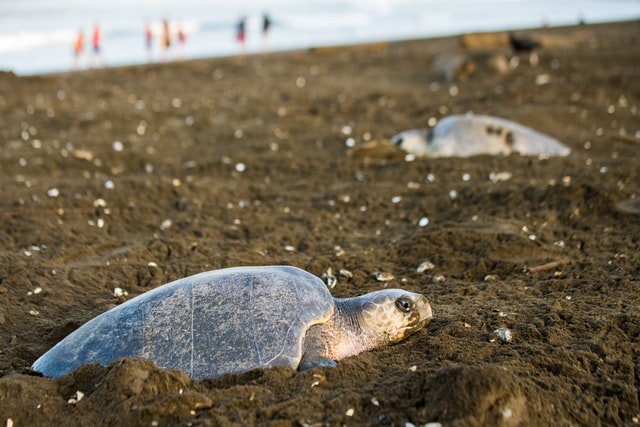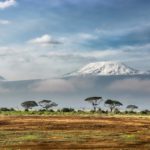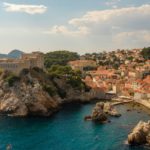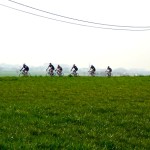Just Another Day on the Beaches of Costa Rica

I run a social enterprise that helps people travel and volunteer with animals. It’s wonderful. New and experienced travellers come to me to help find the perfect animal volunteer experience and I sometimes literally make their dreams come true. My job, realistically, is 90% spent behind a computer. Figuring out new volunteer placements, finding more volunteers, training them and helping them feel comfortable and, of course, getting them to the placement safe and sound and back again.
Every so often I get to go on a placement. Every time we set up a new placement, I get to visit it. I make sure it’s safe, run ethically, supported by the community and also really benefiting the animals. We have been sending people to volunteer since 2012, which means the time has come to revisit our placements, see how they have changed and update our manuals and website.
My partner is a university professor. He teaches psychology, and this summer we decided to take a trip to Latin America. He was interested to see one of our placements, and being an animal lover himself, he wanted to get his hands dirty doing some real citizen science and conservation.
We booked two weeks in Costa Rica and I called our sea turtle conservation partner to give them the good news. Five years after my initial visit I would be visiting again, also looking to get my hands dirty doing hands-on citizen science and marine conservation.
We waited on beautiful deserted beaches of Costa Rica for turtles, swimming and playing cards until the turtles came to shore.
The project we volunteered at was on the Osa Peninsla. It’s a wild and gorgeous area that is known for having 5% of the world’s biodiversity. We would be volunteering with the turtles for a week, and then heading to the Corcovado National Park for three days for hiking and general animal spotting.
Playa Blanca, the town where the sea turtle centre is located, is small and laid back. It’s right on the gulf, surrounded by forests and pastures. Since all our clients stay with local families, we did too. Our homestay was just up the road from the centre, and we were given bikes to ride in every morning.
Our Costa Rican host mother was kind and welcoming, and cooked us three gorgeous and fresh local meals a day. She even got us mosquito nets for our beds when we made the rookie mistake of forgetting ours. She was a welcome sight every morning when we were in need of coffee and gallo pinto (the local specialty of delicious rice and beans), and in the evening when we needed cool water and more gallo pinto.
The sea turtle program had grown since I had visited five years earlier, and I was delighted. The work they do is in water research. They study both sea turtles and mangrove reforestation. There is one marine biologist researcher who runs the program, and four research assistants who stay for three months at a time.
This makes the volunteers’ role one of hands and feet. We help in any way possible. Sometimes that is detangling a net, sometimes it’s planting mangrove seedlings, sometimes it’s measuring a sea turtle – but we will get to that later!
This is what I love explaining to people: it doesn’t matter what background you come from, anyone who loves animals can help on these programs.
My partner had never met a sea turtle before. I have been really lucky to visit five different turtle centres on three continents, so I was really excited for him. Soon he was not only going to be able to see a sea turtle, but to help with the research. How? We don’t know a lot about sea turtles when they are in the sea; 70% of the earth is ocean, so that’s a lot of places for sea turtles to hide! We know their behaviour when they are laying eggs and hatching, but there are lots of questions about how they develop from those eggs to sexual maturity.
In some cases, it can take sea turtles 20-25 years to reach sexual maturity. This project is so important because the researchers put nets into the water to catch the growing sea turtles. They are able to research male turtles (they never come to the beach because they don’t lay eggs) as well as female turtles. They record the sea turtles’ biometrics and tag them. The biometrics help us see roughly how old the sea turtles are, and the tags help us see where they are from and where they are going.
Volunteers are critical because when the sea turtles are caught in the net, they are brought to shore. The volunteers hold the sea turtle to make sure the researchers can take measurements, read the tags, or add tags. The volunteers also help with the measurements and sometimes with parasite clearing. Some sea turtles have quite a few parasites that don’t hurt them but can be a large burden on their immune system. Removing these parasites (after being properly trained) helps the sea turtle be a bit more comfortable. It also helps their general wellbeing, since their body doesn’t have to fight against the parasites.
Just Another Day on the Beaches of Costa Rica.
The mangrove project is equally interesting. An endangered ecosystem, mangrove forests are carbon sinks, stop erosion of coast lines, provide important breeding and rearing grounds for sea creatures and water filtration to make sure the water that goes from the land is clean once it gets to the ocean – and vice versa.
The volunteers help in the mangrove nurseries by watering the baby mangroves, potting and re-potting, planting mangrove saplings and helping record the growth rate of past mangrove seedlings. The more we know about mangroves and where they like to grow, the more we can plant them in the best places and help not just the local ecosystem but the entire global climate.
That is exactly what we did for the week. We waited on beautiful deserted beaches for turtles, swimming and playing cards until the turtles came to shore. Jumping into citizen science action wearing our best rash vests and plastic doctor’s gloves to protect us from the sun and any funny bacteria the turtles may have. We walked to the mangrove sanctuary along beaches under scarlet macaw pairs and sloths. We cooled off in the warm water of the gulf in the afternoon. And we cheers-ed with cool Imperial beer at a local bar at the end of each day.
I had the brief but terrifying experience of having a lizard fall on my head–but at least it wasn’t a snake, so my pants stayed dry.
We ended up helping tag and measure two turtles, and he held a flipper as I helped clear the parasites off of a particularity small hawksbill turtle. We planted a dozen mangrove seedlings. Not bad for a psychology professor. This is what I love explaining to people: it doesn’t matter what background you come from, anyone who loves animals can help on these programs.
When we were finished volunteering, we went to Carate to the south of Corcovado National Park. We hired a guide from a local amazing company called Osa Wild. They hire Costa Rican biologists and pay them ethically. It was clearly the best choice, because within two minutes of starting the tour we saw a whole troop of white-faced Capuchin monkeys!
We went on to see ant eaters, river otters, spider monkeys, dart frogs, a crested owl, toucans and coatis. I had the brief but terrifying experience of having a lizard fall on my head–but at least it wasn’t a snake, so my pants stayed dry. Looking out into the ocean you could see sea turtles come up to breathe, and in the far distance we saw dolphins looking for a meal.
The whole trip was a nature-lover’s dream. However, it didn’t help me convince my partner that most of my job is actually behind the computer helping others live this adventure.









There are tonnes of beautiful animals to see everywhere, make sure you have your camera ready! In terms of insects, just remember to bring a bug net to put over your bed while you sleep. 🙂
Thankfully it was just a lizard! I am looking forward to getting to know Costa Rica soon, but the amount of animals and insects is a bit overwhelming from what I have heard…